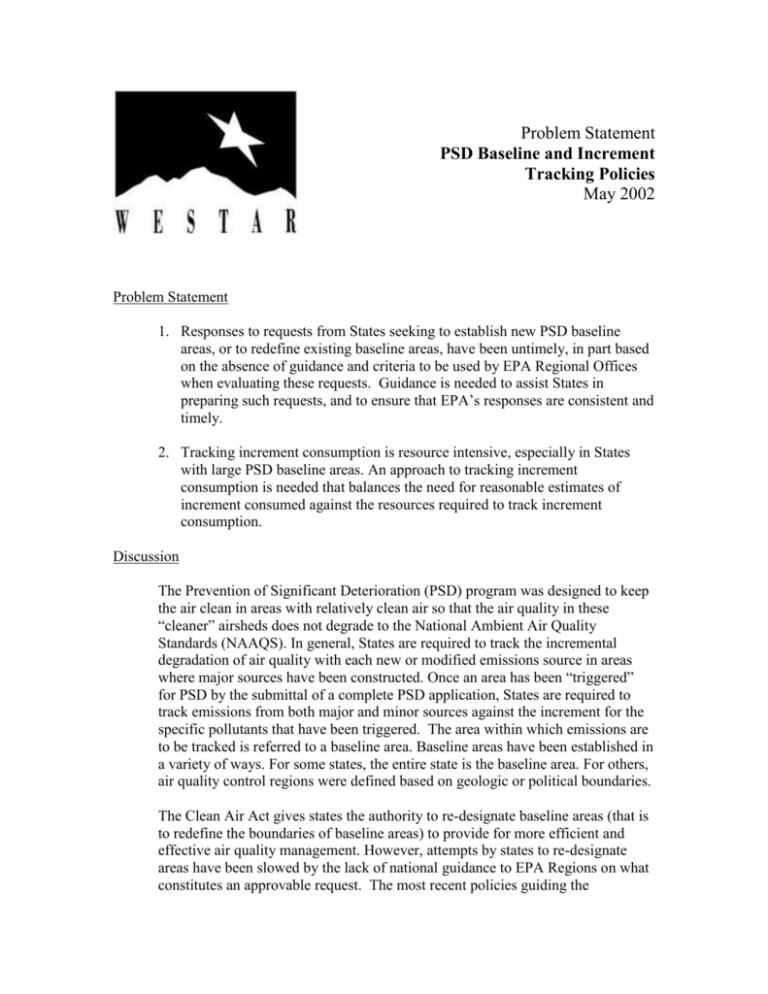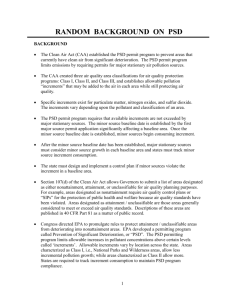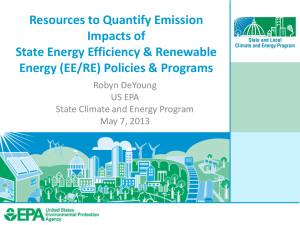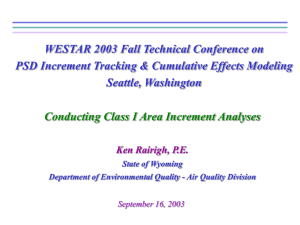Problem statement
advertisement

Problem Statement PSD Baseline and Increment Tracking Policies May 2002 Problem Statement 1. Responses to requests from States seeking to establish new PSD baseline areas, or to redefine existing baseline areas, have been untimely, in part based on the absence of guidance and criteria to be used by EPA Regional Offices when evaluating these requests. Guidance is needed to assist States in preparing such requests, and to ensure that EPA’s responses are consistent and timely. 2. Tracking increment consumption is resource intensive, especially in States with large PSD baseline areas. An approach to tracking increment consumption is needed that balances the need for reasonable estimates of increment consumed against the resources required to track increment consumption. Discussion The Prevention of Significant Deterioration (PSD) program was designed to keep the air clean in areas with relatively clean air so that the air quality in these “cleaner” airsheds does not degrade to the National Ambient Air Quality Standards (NAAQS). In general, States are required to track the incremental degradation of air quality with each new or modified emissions source in areas where major sources have been constructed. Once an area has been “triggered” for PSD by the submittal of a complete PSD application, States are required to track emissions from both major and minor sources against the increment for the specific pollutants that have been triggered. The area within which emissions are to be tracked is referred to a baseline area. Baseline areas have been established in a variety of ways. For some states, the entire state is the baseline area. For others, air quality control regions were defined based on geologic or political boundaries. The Clean Air Act gives states the authority to re-designate baseline areas (that is to redefine the boundaries of baseline areas) to provide for more efficient and effective air quality management. However, attempts by states to re-designate areas have been slowed by the lack of national guidance to EPA Regions on what constitutes an approvable request. The most recent policies guiding the implementation of the PSD program were written in the early 1980’s and have received new scrutiny over the past few years as the regional affects of air pollution on Class I areas have become more widely known. While federal land managers believe that large baseline areas may foster a more comprehensive evaluation of the regional-scale impact of a proposed new source, it can be a significant burden on a state to track emissions from all sources over a large area and can hinder economic development in rural areas of a state. In a recent Federal Register notice (83 FR 21194), EPA provides some examples of the types of re-designations that might interfere with effective air quality management to include “those areas that would have the effect of un-triggering a minor source baseline date in an area affecting a Class I area or in an area where a substantial portion of the available increment has been consumed, re-designations that serve to carve out small “postage stamp” areas encompassing only the significant impact area around a major PSD source, or large-scale re-designations creating numerous small baseline areas with little or no basis in effective management of air quality.” These broad principals need to be discussed with the states in an open forum, then refined and clarified to provide states with the guidance necessary to prepare and submit approvable re-designation requests. Per EPA Guidelines, increment consumption and expansion tracking should be based on actual emissions. This places the burden upon states to conduct annual emissions inventories for point and area, major and minor sources of air pollution. Although many states perform an annual inventory for major sources, inventorying minor sources and area sources over large areas is not a trivial task and would involve a great amount of manpower and resources to do so accurately. EPA guidance allows states to use allowable emission rates (permitted emission rates) in the absence of actual emission rate data; however, with most sources requesting permitted levels well above their actual emission rates, this can create large under and overestimates of increment consumption. Even with the use of allowable emission rates, area source emission rate determinations are error-prone and are difficult to calculate and inventory.








